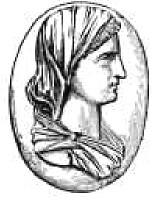According to the Muratorian fragment, the Testamentum at one point included an Epistle to the Alexandrians.
Many scholars have claimed that the Epistle to the Alexandrians was the ancient and original name of the Epistle to the Hebrews. Alexandria itself was the second largest Jewish city at the time after Jerusalem, and an early Jewish-Christian community flourished there.
The Epistle to the Hebrews was the only Pauline Epistle missing from the Muratorian fragment, and specifically, it was the only non-pastoral letter left in the Pauline corpus.
Clement of Alexandria believed the Epistle to the Hebrews (Alexandrians) was written anonymously due to Paul the Apostle’s negative reputation among Jews and Jewish Christians. Clement of Alexandria also suggested the Epistle to the Alexandrians (Hebrews) was only translated into Greek much later. Like the Apostle Paul, Marcion focused primarily on converting and evangelizing Gentiles and would have had less contact with the Jewish-Christian communities where the Epistle to the Alexandrians (Hebrews) circulated.
Some scholars have proposed that the Apostle Paul may have used an amanuensis, or secretary, in writing the disputed letters. The Epistle to the Alexandrians, references the epistle being dictated to Tertius the Deacon while the Apostle Paul was in prison.
All these reasons may explain why the text of the Pastorals and Alexandrians differs from the traditional Pauline corpus found in the Apostolicon.
It is possible that at some point, the letter became a ‘circular-letter’ where the original destination of the epistle was either forgotten or purposefully removed, and the letter was simply exchanged to multiple Jewish-Christian communities across the Eastern Mediterranean, adopting the name ‘Epistle to the Hebrews’ to be more inclusive of the new broader audience.
The opening greetings of the Epistle to the Alexandrians was reconstructed using the 16th chapter of the Epistle to the Romans.
Several scholars have argued, largely on the basis of internal evidence, that the 16th chapter of Romans represents the opening of a separate letter of Paul that was later appended to the Epistle to the Romans erroneously.
It is worth noting that in many manuscripts, the Epistle to the Hebrews immediately follows the Epistle to the Romans. This may explain how, through a scribal error, the original opening of the Epistle to the Hebrews got attached to the end of the preceding Epistle to the Romans.
We know from the conclusion of the Epistle to the Alexandrians (Hebrews) that it was written by Paul from Rome, and the 16th chapter of Romans contains salutations and greetings from numerous Christians in Rome that Paul only would have known of had Paul already been in the city.
Of note, one of the Christians mentioned by the Apostle Paul in these greetings and salutations is the father of Marcion of Sinope, one of the 70 Disciples of Jesus Christ, Philologus of Sinope:
“Salute Philologus, and Julia, Nereus, and his sister, and Olympas, and all the saints which are with them.” (Alexandrians 1:15)
Many scholars support a 14- or 15-chapter version of the Epistle to the Romans, thus excluding the 16th chapter. This aligns with the original Marcionite Christian version of the Epistle to the Romans.
The prologue of the Epistle to the Alexandrians was reconstructed using an unused Latin prologue to the Epistle to the Ephesians
While this epistle was not originally included in Marcion’s Apostolicon, it was not because he necessarily rejected it; it is more likely that Marcion simply did not know of it during his time. Based on all the evidence above, it is clear that later, Marcionite Christians eventually included the Epistle to the Alexandrians as part of an expanded canon of texts.
For the reconstruction of the Epistle to the Alexandrians, the Marcionite Church of Christ took a largely minimalist approach since the Epistle to the Hebrews is already disputed and challenged as an authentic writing of the Apostle Paul. We only included verses directly cited, alluded to, or attested to by Clement of Alexandria, an early Christian theologian who lived ca. 200 AD. This was done to reconstruct this epistle to be closer to its original and shorter form. In addition to Clement of Alexandria, we relied on other direct citations, allusions, and attestations from 2nd-century patristic sources such as Hermas, Tatian, Theophilus, and Athenagoras.
The reconstruction of the Epistle to the Alexandrians relied on patristic sources collected and referenced primarily in the work of Maegan C.M. Gilliland (The Text of the Pauline Epistles and Hebrews in Clement of Alexandria, 2016) and secondarily in the work of Philip Schaff (Ante-Nicene Fathers, 1885).
Like the other Pauline works, this epistle was expanded upon, interpolated, and edited by later Christians to comport with the emerging orthodoxy of the Church.
The Epistle to the Alexandrians will be included in the Testamentum going forward within a new section known as the Antilegomenon. The Antilegomenon includes all the epistles of the Apostle Paul, whose authenticity or value is disputed.
These epistles were not included in the original compilation of Marcion’s Apostolicon, but the Marcionite Church of Christ views these texts as a second canon or ‘deuterocanonical.’
These texts are useful to read for theological and historical purposes but are not equal to the Evangelicon and Apostolicon. Unlike apocryphal books, these texts may occasionally be used for liturgical purposes.
If, in the future, these texts can be definitively confirmed to be authentic works of the Apostle Paul, and their original, non-interpolated versions are found or can be reconstructed, the Marcionite Church of Christ would consider them to be included in the Apostolicon proper.
You can read the reconstruction of the Epistle to the Alexandrians here.



